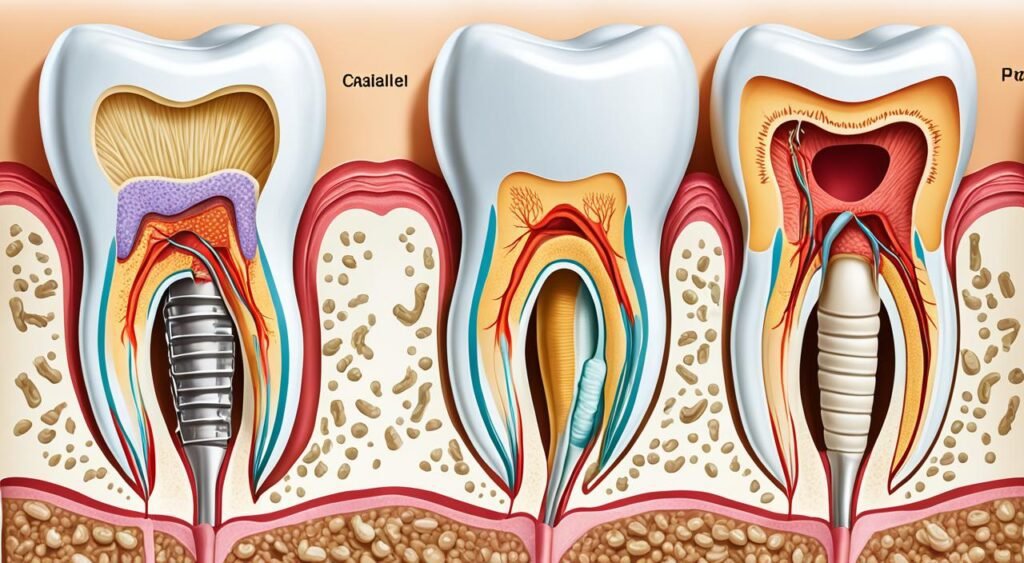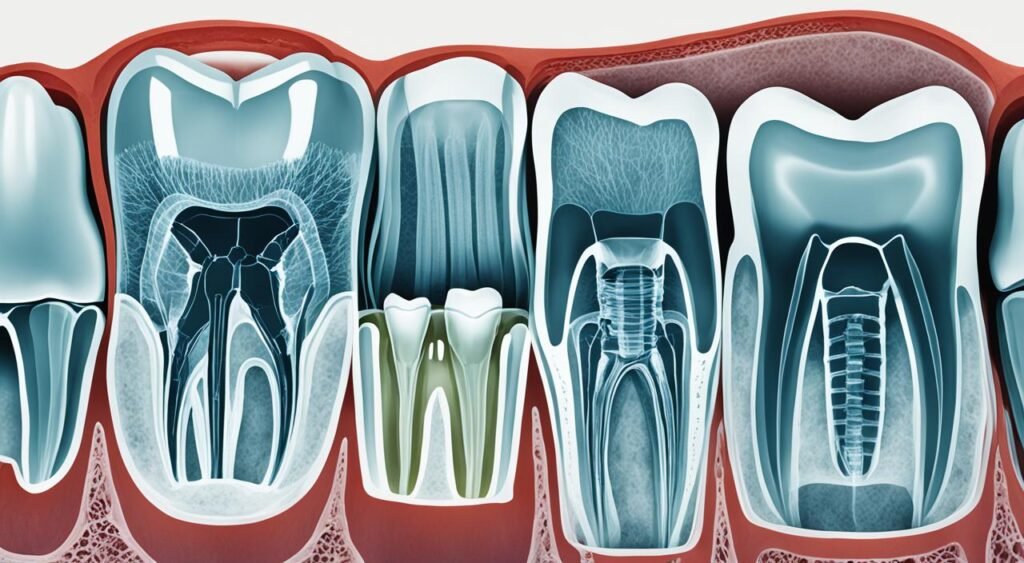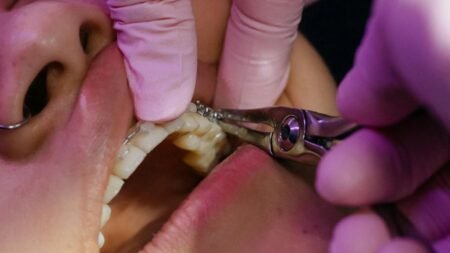Imagine turning a dental threat into a reason to smile. Root cavities grow faster than other cavities, making them a big health concern. At age 70, the risk gets much higher due to various dental issues. But, early treatment can save your smile. Options like fluoride treatments and more complex root canals are available.
Key Takeaways
- Root cavities progress twice as fast, needing quick management.
- They become a bigger risk at age 70, because of issues like receding gums.
- Smoking increases the chances of getting periodontitis and root cavities.
- Using fluoride professionally or at home helps defend against root cavities.
- Tooth health is maintained by good hygiene, less sugar, and regular dental check-ups.
- Root cavity treatments vary, from fillings to extraction, showing early care is essential.
Understanding Root Cavities: An Overview
Root cavities are a serious type of dental caries. They can cause big problems by damaging your enamel. Unlike regular cavities, these grow on roots. This happens when gums pull back. This lets germs attack the root with plaque. Root cavities are risky because they’re hard to spot at first. They show up where your gums have moved away, making the roots easy targets for bacteria.
What are Root Cavities?
When gums go back, they leave the roots out in the open. This is a big issue for older adults, but it can also happen to younger people. The part of the tooth below the gum line is not as tough as the top layer. So, it’s easy for the soft part to get cavities. And this can hurt the hard outside layer of your tooth too.
Causes and Risk Factors of Root Decay
Getting older makes you more likely to have root cavities. This is because gums move back over time. Not taking care of your teeth well adds to this risk. Things like not brushing enough can make the problem worse. Health issues like diabetes make it even easier for cavities to form.
Identifying the Symptoms of Tooth Root Cavities
Cavities on roots feel like other problems but can get worse quickly. You might feel pain when you eat or drink something hot or cold. There might be visible signs of damage too. If not treated, it can lead to bad pain, infections, or even losing your tooth. Seeing a dentist often is key. They can spot issues early and stop the harm before it’s too late.
Keeping your teeth healthy is vital. Brushing, flossing, and regular dental visits can prevent root cavities. Knowing the signs means you can get help early. This way, you protect your smile and avoid more serious problems. Comic_Configurator

Professional Diagnosis: Detecting Root Cavities
Giving attention to your oral health is vital. A dental examination by professionals is key. They use your health history, look closely, and use special tools to spot root cavities early. This could keep you from needing a lot of dental work later on.
The Role of Dental Exams and X-rays
At a dental examination, the dentist goes over your health history. This helps spot any issues that might affect teeth. They also visually check your teeth and gums for decay signs. But, to fully check your teeth, they might use dental X-rays. These show areas between teeth and under gums well. They are a must for spotting cavities early.
Types of Cavities and How They Are Diagnosed
There are three types of cavities: smooth, pit and fissure, and root. Each kind needs a specific method for detection. Today, with laser devices and digital imaging, finding cavities is more accurate and less bothersome. Dentists usually start by looking and then gently exploring with tools to find soft spots.
Keeping up with dental check-ups is vital. And acting right away if you feel any pain or sensitivity is key. Treatments for root cavities are now more efficient. This means healthier teeth and smiles with not as much invasion.
Root Cavity Treatment Options to Consider
When you have a root cavity, your dentist will pick from several treatment options. The right method depends on how bad the decay is. Finding the cavity early means you might only need a fluoride treatment. This treatment can fix the enamel and stop more decay.
In some cases, you might need dental fillings, crowns, or a root canal therapy.
Fluoride treatment is great for early stage root cavities. It’s a simple step that involves putting strong fluoride on your teeth. This can make your enamel stronger, keeping cavities away. When cavities go deeper, you’ll need dental fillings. These fillings repair the tooth and can look like your natural teeth.
If the decay is quite bad, you might get a dental crown. Crowns cover and protect the whole tooth. They are usually made to look natural, with materials like porcelain. If the decay hits the tooth’s center, you’ll need a root canal therapy. This includes cleaning out the damaged part of the tooth and sealing it off to stop more harm.
Here’s a quick look at what each treatment does:
| Treatment | Use Case | Benefits |
|---|---|---|
| Fluoride Treatment | Early stages of root cavities | Helps restore enamel, non-invasive |
| Dental Fillings | Minor to moderate decay | Restores tooth structure, relatively quick procedure |
| Crowns | Moderate to severe decay | Offers strength and aesthetics, protects against further decay |
| Root Canal Therapy | Decay involving the tooth pulp | Removes infection, preserves natural tooth |

Talking to your dentist is key to figuring out the best plan for you. Getting help early can keep treatments simple. This protects your teeth and your smile.
At-Home Cavity Treatment: Measures You Can Take
Tooth decay is usually a job for the pros, but you have power at home too. You can use certain methods to ease the pain and keep your smile healthy. Start by using toothpaste with fluoride and remedies for sensitive teeth.
Temporary Pain Relief Techniques
If a cavity is causing you pain, try over-the-counter pain meds first. But, there are also home remedies that might help. Gargling with warm, salty water is one. It’s good for easing the sting. And if your teeth are sensitive, avoid drinks that are too hot or too cold. They can trigger sharp jabs of pain.
A pain-numbing cream on the gums near the sore tooth might dull the ache too. It’s a quick fix till you see the dentist.
Importance of Fluorage in At-Home Treatment
Using fluoride toothpaste is one key to fighting cavities at home. Fluoride hardens your tooth enamel, making cavities less likely. Make sure you brush often with fluoride toothpaste. Do it after eating to cut down the plaque.
Fluoride mouthwash is another good idea. It protects teeth in places where your brush can’t quite reach. Together, these fluoride products build a strong shield against decay.
Don’t forget the basics: brush your teeth twice a day and floss once daily. This routine boosts the power of fluoride toothpaste and keeps your mouth clean. By doing this, you reduce your chances of getting cavities. And it also helps with sensitive teeth. Keep at it to take great care of your teeth and avoid cavities.
Cavity Treatment Cost: Investment in Your Oral Health
Knowing the cavity treatment cost is important for your budget. It helps you maintain great oral health without sudden expenses. The price of filling a cavity may vary due to different factors.
Whether you have dental insurance or not, understanding costs is key. Dental insurance can help a lot, but how much depends on your plan and the filling material.
| Fillings Type | Cost Without Insurance | Cost With Insurance |
|---|---|---|
| Silver Amalgam | $50 – $250 | $30 – $150 |
| Composite Resin | $100 – $450 | $70 – $300 |
| Gold | $1,000 – $1,500 | $900 – $1,400 |
| Porcelain | $300 – $4,500 | $250 – $4,000 |
This table shows how costs can differ by material. Paying more upfront for gold or porcelain can be worth it for their quality and looks. Remember, regular dental visits and cleanings are key parts of your oral health investment.
Preventing cavities is a smart move. Using fluoride toothpaste and seeing your dentist twice a year can lower your risks. Don’t forget, there are affordable choices for care like dental schools or discount plans if you don’t have dental insurance.
Being proactive about cavity treatment cost and what your dental insurance covers can help your oral and money health. Investing in your smile pays off in the long run for your health and pocket.
Smooth Surface Cavity Treatment: Addressing the Lesser-Known Type
Do you know that smooth surface cavities are easy to stop? They usually happen on the flat parts of your teeth. These cavities can be kept at bay with good dental care. Things like brushing and flossing regularly help a lot.
One way to fight smooth surface cavities is with dental sealants. These are coatings that protect your teeth from acid. This acid is made by plaque, and it can damage your teeth. Sealants are great for kids, teens, and even adults who get lots of cavities.
Fluoride is also key in treating these cavities. Studies show that fluoride can help fix early tooth damage. It might even turn back the clock on cavities. Getting fluoride from water, toothpaste, or your dentist can make your teeth stronger.
- Brushing twice a day with fluoride toothpaste.
- Flossing daily gets rid of plaque in tight spots.
- Scheduling at least two dental check-ups a year is important.
Eating less sugar and acid can help keep your teeth free from cavities. Also, eat more foods that are good for your teeth. This includes veggies, nuts, and fruits with lots of fiber.
If smooth surface cavities get worse, you might need fillings or crowns. In the worst cases, you could need a root canal or to have the tooth taken out. But, catching and treating cavities early can help you avoid these big steps.
Preventing cavities is a smart move for your health and your smile. Good oral care, sealants, and regular check-ups can keep your teeth healthy.
Conclusion
Maintaining good oral health needs watchfulness and a routine. Having strong strategies for dental health maintenance is key. This, along with regular dental visits and taking care of your teeth well, helps in keeping cavities at bay.
Early action when you notice a problem and using new techniques and tools can make your dental treatment work better and last longer.
It’s important to know that your teeth can bounce back after treatments like root canals, especially with advanced methods used by experts like Dr. Michael Koumas in Newburgh, NY. Being proactive about things like tooth pain can stop more serious treatments later on.
Your dental health reflects your overall health and deserves careful attention. With experts such as Dr. Koumas and their modern treatments, achieving a healthy and bright smile is possible. Make regular visits to the dentist a big part of your health routine. With good care, your smile’s strength and beauty can be long-lasting.
FAQ
What Exactly Is a Root Cavity?
A root cavity is a type of dental caries. It affects the area above the tooth roots. This happens when tooth enamel breaks down due to acids from plaque, causing decay.
What Causes Root Decay and Who Is at Risk?
Causes of root decay include poor oral hygiene, too many snacks, and sugary drinks. Certain factors like older age, gum disease, and diabetes can heighten the risk by increasing inflammation.
How Can I Tell If I Have a Tooth Root Cavity?
Signs of a root cavity are pain, sensitivity to hot or cold, and gum recession. If you have these symptoms, you should visit a dentist. Only they can confirm if you have a root cavity.
How Important Are Dental Exams and X-rays in Diagnosing Root Cavities?
Exams and X-rays are key for finding root cavities early. They show dentists cavities’ severity and help plan treatment. These tools also find cavities where they’re hard to see with just an exam.
Can You Describe the Different Cavity Types and How They Are Diagnosed?
Cavities come in three main types: smooth surface, pit and fissure, and root cavities. Dentists identify each type through exams, symptoms from the patient, and X-rays. Every type shows different signs that tell the dentist what it is.
What Treatments Are Available for Root Cavities?
Treatments for root cavities include fluoride, fillings, crowns, and in some cases, root canals. If a cavity is very bad, the tooth might need to be pulled. Then you could get a bridge or an implant to replace the tooth.
What Can I Do at Home to Manage Cavity Pain?
You can take over-the-counter pain medicine and use numbing gels at home for pain. For sensitive teeth, fluoride toothpaste can help. But remember, seeing a dentist is still important for root cavity care.
Why Is Fluoride Important in At-Home Cavity Prevention and Treatment?
Fluoride makes your tooth enamel stronger, fighting off plaque acid. Using fluoride toothpaste and mouthwash helps stop cavities and might even fix early tooth decay.
How Much Does Cavity Treatment Typically Cost, and Will Dental Insurance Cover It?
Cavity treatment prices change based on the type of care, from simple fluoride to major procedures like root canals. Dental insurance usually pays for some, but not all, of the cost. Always check your plan to see what’s covered.
What Is a Smooth Surface Cavity and How Is It Treated?
Smooth surface cavities are on teeth’s flat sides and they grow slowly. These can be fixed with fluoride or sealants to protect the enamel. It’s also vital to keep your teeth clean to manage these cavities.
As an Older Adult, How Should I Adjust My Dental Care Routine?
If you’re older and at a higher risk for cavities, keep your teeth clean and see your dentist often. They can give you tips for preventing cavities. A routine of good oral care is essential.








